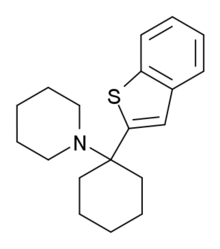Benocyclidine
Benocyclidine, also known as benzo
 | |
| Clinical data | |
|---|---|
| ATC code |
|
| Legal status | |
| Legal status |
|
| Identifiers | |
| |
| CAS Number | |
| PubChem CID | |
| ChemSpider | |
| UNII | |
| ChEMBL | |
| CompTox Dashboard (EPA) | |
| Chemical and physical data | |
| Formula | C19H25NS |
| Molar mass | 299.48 g·mol−1 |
| 3D model (JSmol) | |
| |
| |
| | |
It acts as a potent and selective dopamine reuptake inhibitor (DRI) and a psychostimulant.[2][3] Unlike related compounds like phencyclidine and ketamine, benocyclidine is a pure DRI with negligible affinity for the NMDA receptor, and it therefore lacks any anticonvulsant, anesthetic, hallucinogenic, or dissociative effects.[2][3] It has been used to label the dopamine transporter.[4][5]
BCP was also used to try to find a common pharmacophore for DRI type stimulants.[6]
More recently, benocyclidine has been found in several ecstasy tablets, sold as MDMA.[7]
Legal status
United States
Benocyclidine is not scheduled at the federal level in the United States,[8] but may be considered an analog of PCP, in which case purchase, sale, or possession could be prosecuted under the Federal Analog Act.
Florida
"Benocyclidine (BCP) or benzothiophenylcyclohexylpiperidine (BTCP)" is a Schedule I controlled substance in the state of Florida making it illegal to buy, sell, or possess in Florida.[9]
See also
References
- PCT Patent Application WO199712513 (see also US Patents Nos.5,866,756 and 6,218,595
- Vignon J, Pinet V, Cerruti C, Kamenka JM, Chicheportiche R (1998). "[3H]N-[1-(2-benzo(b)thiophenyl)cyclohexyl]piperidine ([3H]BTCP): a new phencyclidine analog selective for the dopamine uptake complex". Eur J Pharmacol. 148 (3): 427–436. doi:10.1016/0014-2999(88)90122-7. PMID 3384005.
- Chaudieu I, Vignon J, Chicheportiche M, Kamenka JM, Trouiller G, Chicheportiche R (1989). "Role of the aromatic group in the inhibition of phencyclidine binding and dopamine uptake by PCP analogs". Pharmacol Biochem Behav. 32 (3): 699–705. doi:10.1016/0091-3057(89)90020-8. PMID 2544905.
- Filloux F, Hunt MA, Wamsley JK (1989). "Localization of the dopamine uptake complex using [3H]N-[1-(2-benzo(b)thiophenyl)cyclohexyl]piperidine ([3H]BTCP) in rat brain". Neurosci. Lett. 100 (1–3): 105–110. doi:10.1016/0304-3940(89)90668-X. PMID 2527343.
- Maurice T, Vignon J, Kamenka JM, Chicheportiche R (1989). "In vivo labelling of the mouse dopamine uptake complex with the phencyclidine derivative [3H]BTCP". Neurosci. Lett. 101 (2): 234–238. doi:10.1016/0304-3940(89)90537-5. PMID 2771169.
- Froimowitz M, Wu KM, Rodrigo J, George C (2000). "Conformational preferences of the potent dopamine reuptake blocker BTCP and its analogs and their incorporation into a pharmacophore model". J Comput Aided Mol Des. 14 (2): 135–46. doi:10.1023/A:1008144707255. PMID 10721502.
- "EcstasyData Testing Result: Blue Butterfly". Ecstasy and other drug testing. Erowid Center. Retrieved 2 February 2012.
- 21 CFR — SCHEDULES OF CONTROLLED SUBSTANCES §1308.11 Schedule I.
- Florida Statutes - Chapter 893 - DRUG ABUSE PREVENTION AND CONTROL